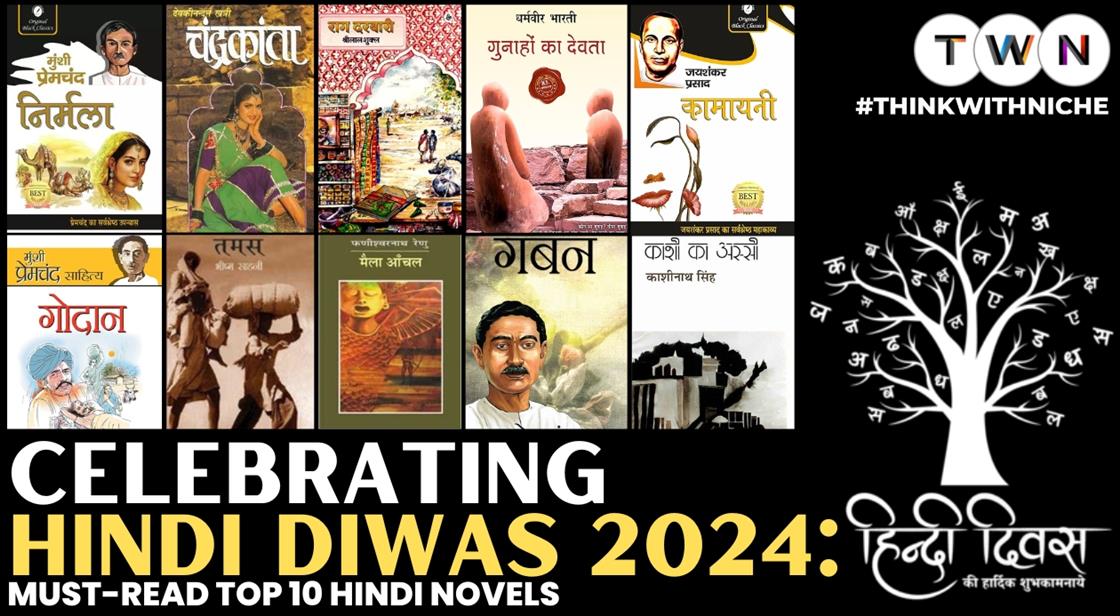Celebrating Hindi Diwas 2024: Must-Read Top 10 Hindi Novels

Blog Post
Hindi Diwas, celebrated annually on September 14, commemorates the adoption of Hindi as one of India’s official languages in 1949. This day is dedicated to recognizing the significance of Hindi in unifying diverse cultures and promoting national identity. It serves as a reminder of the language’s profound impact on Indian literature and its role in shaping societal values and cultural narratives.
In honor of Hindi Diwas 2024, this blog explores ten iconic Hindi novels that have left an indelible mark on the literary landscape. These novels span various genres and periods, showcasing the rich tapestry of Hindi literature.
From the profound social commentaries of Munshi Premchand to the imaginative fantasy of Devaki Nandan Khatri, these works reflect the diverse themes and cultural heritage embedded in Hindi literature.
Reading these novels not only offers a glimpse into India’s literary heritage but also provides valuable insights into the societal issues, cultural nuances, and philosophical reflections that have shaped and continue to influence Indian society.
As we celebrate Hindi Diwas, revisiting these masterpieces allows us to appreciate the depth and breadth of Hindi literature and its enduring legacy in the world of books.
#HindiDivas2024 #HindiDay2024 #HindiLiterature #HindiLanguage #HindiNovels #LoveForHindi
Top 10 Iconic Hindi Novels to Read on Hindi Diwas 2024
Hindi Diwas, celebrated on September 14 every year, marks the day in 1949 when Hindi, written in the Devanagari script, was adopted as one of the official languages of India. This day honors the language's importance in unifying the country and promoting cultural identity. Hindi Diwas is a time to reflect on the richness of Hindi as a language and its role in the development of Indian society.
Significance of Hindi Diwas in Promoting Hindi Language and Literature
Hindi Diwas plays a crucial role in raising awareness about the Hindi language's role in Indian culture. It encourages efforts to preserve and promote Hindi literature, which includes novels, poetry, and prose that have shaped India's literary landscape. Events, competitions, and discussions held on Hindi Diwas aim to instill pride in the language and inspire future generations to engage with Hindi literature.
Importance of Hindi Literature and Its Rich Cultural Heritage
Legacy of Hindi Literature
Hindi literature is a reflection of India's diverse traditions, values, and cultural heritage. From ancient epics to modern-day novels, Hindi literature has served as a medium to express the thoughts, struggles, and aspirations of the people. Renowned writers such as Munshi Premchand, Harivansh Rai Bachchan, and Bhisham Sahni have created timeless works that highlight societal issues, human emotions, and moral dilemmas.
Rich Cultural Heritage in Hindi Novels
Hindi novels play an essential role in preserving India's cultural identity. These works offer a deep insight into the social fabric, traditions, and historical changes in Indian society. Novels such as Godaan and Tamas provide a literary window into India’s rural life, politics, and the challenges faced by common people.
Role of Hindi Novels in Shaping Society
Influence on Society and Culture
Hindi novels have had a profound impact on shaping societal values, critiquing social injustices, and fostering cultural awareness. By addressing themes like love, social inequality, and human resilience, Hindi novels have contributed significantly to the development of thought and discourse in Indian society.
1. Godaan by Munshi Premchand
Godaan is set in the rural landscape of pre-independence India, capturing the essence of village life with remarkable depth and authenticity. The novel revolves around the life of Hori, a poor farmer, and his family, depicting their struggles and aspirations. The story presents the challenges faced by farmers, portraying the harsh realities of agrarian society.
Portrayal of Socio-Economic Inequalities and Farmer Struggles
Premchand masterfully illustrates the socio-economic inequalities that plague rural India. Through Hori's character, the novel delves into the exploitation of farmers by moneylenders, landlords, and the corrupt bureaucracy. Hori’s dream of owning a cow, which symbolizes both material and spiritual fulfillment, becomes the central motif, highlighting the hardships and unending cycle of poverty that many farmers endure.
Impact on Hindi Literature and Its Relevance Today
Godaan is considered one of the greatest works of Hindi literature. It has had a profound influence on Indian readers, bringing attention to the plight of rural farmers. The novel’s exploration of social justice, caste dynamics, and economic disparity remains relevant today, as many of the issues depicted by Premchand still resonate in modern India. Godaan not only enriched Hindi literature but also laid the foundation for future works that address social inequality and human suffering.
Also Read: Swami Vivekananda: Life Lessons From The Great Young Leader
2. Raag Darbari by Shrilal Shukla
Raag Darbari is a biting satire that critiques the socio-political conditions in post-independence rural India. Set in the fictional village of Shivpalganj, the novel highlights the dysfunctional political and bureaucratic systems that dominate rural governance. Through humor and wit, Shrilal Shukla paints a grim picture of how the aspirations of independent India are stifled by corruption, hypocrisy, and inefficiency.
Exploration of the Corrupt Systems Depicted in the Story
The novel exposes the widespread corruption in government institutions, education, and village leadership. Vaidyaji, the local power-broker, uses his influence to manipulate the system for personal gain, representing the entrenched self-interest and moral decay that has seeped into every aspect of rural life. The village school, courts, and local governance, all serve as tools of exploitation rather than development, mirroring the stagnation of rural progress.
How Raag Darbari Resonates with Modern Readers
Despite being published in 1968, Raag Darbari continues to resonate with modern readers due to its timeless portrayal of corruption and power struggles. The novel's relevance lies in its portrayal of issues that still plague rural India, including bureaucracy, nepotism, and the misuse of authority. Its satirical tone and incisive critique of society make it a cornerstone of modern Hindi literature, influencing contemporary political and social discourse.
3. Maila Anchal by Phanishwar Nath Renu
Maila Anchal by Phanishwar Nath Renu is a masterpiece of Hindi literature, offering a vivid portrayal of village life in Bihar during the post-independence era. Through the eyes of its characters, Renu captures the intricacies of rural society, reflecting the socio-political changes and struggles faced by ordinary people.
Themes of Poverty, Love, and Human Endurance
At the heart of Maila Anchal are themes of poverty, love, and the resilience of human spirit. The novel explores the economic hardships that rural communities endure, highlighting the challenges of poverty and the disparities in wealth and power. Love also plays a central role in the story, depicting relationships bound by societal norms yet enduring despite hardships. The villagers’ endurance, their capacity to persevere, and their hopes for a better life resonate throughout the novel.
Renu’s Unique Style of Depicting Rural India
Phanishwar Nath Renu’s writing stands out for its lyrical quality and rich depiction of rural India. He skillfully combines realism with regional dialects, folk traditions, and cultural nuances to paint a picture of village life that is both beautiful and raw. His portrayal of rural landscapes is infused with a deep sense of affection for the land, yet he does not shy away from illustrating the hardships and injustices that define the lives of his characters.
4. Gunahon Ka Devta by Dharamvir Bharati
Gunahon Ka Devta, written by Dharamvir Bharati, centers around the poignant and unfulfilled love between Chander, a thoughtful and introspective man, and Sudha, a lively and innocent young woman. Their bond, although strong, remains platonic due to societal norms and personal dilemmas. Chander's internal struggle between his love for Sudha and his sense of duty is central to the story.
Emotional Depth and Philosophical Exploration of Love, Morality, and Sacrifice
The novel delves deeply into human emotions, examining how love can transcend physical desire. Bharati weaves themes of morality and sacrifice, as Chander's love for Sudha remains unexpressed, guided by his moral obligations and respect for societal expectations. The emotional intensity of the characters and their internal conflicts make the story profound, touching on the complexities of love that goes beyond mere romantic fulfillment.
Iconic Status in Hindi Literature
Gunahon Ka Devta has earned its place as one of the most beloved romantic novels in Hindi literature. Its philosophical exploration of love, duty, and the human condition resonates with readers across generations. The novel's ability to capture the emotional turmoil of its characters in the context of social and moral constructs has made it an enduring classic, influencing the way love and sacrifice are portrayed in Indian literature.
5. Tamas by Bhisham Sahni
Tamas, written by Bhisham Sahni, is set during the partition of India in 1947, a traumatic period that witnessed large-scale displacement, communal violence, and the division of the country into India and Pakistan. The novel provides a vivid portrayal of the chaos and suffering experienced by people from all communities as they grappled with the political and social upheaval caused by partition. Sahni’s narrative is grounded in historical reality, offering a deeply emotional and realistic depiction of the events leading up to and following the partition.
Themes of Communal Violence, Displacement, and the Human Cost of Political Decisions
The central theme of Tamas revolves around the eruption of communal violence, which tore apart the social fabric of towns and villages across India. The novel captures the brutality of riots between Hindus, Muslims, and Sikhs, showing how political decisions at the highest levels resulted in mass displacement, suffering, and the breakdown of relationships between neighbors. Through the stories of various characters, Sahni illustrates how ordinary people were caught in the crossfire of political agendas, leading to immense loss and devastation.
Bhisham Sahni’s Contribution to the Historical Narrative of India
By writing Tamas, Bhisham Sahni made a significant contribution to the historical narrative of India. The novel provides a human perspective on the tragedy of partition, emphasizing the personal costs of political conflicts. It serves as both a powerful reminder of the horrors of partition and a call for reflection on the consequences of communal hatred and division.
6. Kamatipura by Jaishankar Prasad
"Kamatipura" is a novel by Jaishankar Prasad that explores complex social and moral themes. The story is set in a fictional city, specifically within a brothel district, which provides the backdrop for the narrative.
Social and Moral Dilemmas
The novel delves into the social issues and moral conflicts of its time. It addresses the ethical and societal challenges faced by individuals living in a marginalized community. The setting of a brothel district highlights issues related to social stigma, exploitation, and the struggle for dignity.
Setting
The novel is set against the backdrop of a brothel district in a fictional city. This setting is crucial as it reflects the harsh realities and societal attitudes of the time, providing a lens through which the characters’ lives and struggles are examined.
Human Relationships
"Kamatipura" explores the complexities of human relationships within this challenging environment. It portrays the interactions between characters, revealing their emotional and psychological depth as they navigate their personal and societal conflicts.
Societal Norms
The novel also critiques the prevailing societal norms and expectations. Through its narrative, it reflects on how these norms impact individuals, particularly those marginalized by society, and how they influence personal choices and relationships.
"Kamatipura" is a poignant exploration of social and moral issues, set in a brothel district, and offers a critical look at human relationships and societal norms.
7. Gaban by Munshi Premchand
Gaban by Munshi Premchand delves into the themes of greed and societal expectations through its central character, Ramnath. The novel portrays Ramnath’s struggle as he becomes entangled in a web of deceit and moral conflict, driven by his desire to fulfill social expectations and attain wealth. His pursuit of material success leads him to make ethically questionable decisions, highlighting the destructive nature of unchecked ambition and societal pressures.
Premchand’s Focus on Moral Dilemmas and Human Fallibility
Premchand’s narrative is rich with moral dilemmas and examines the fallibility of human nature. Through Ramnath’s journey, the author explores the consequences of compromising one’s integrity for personal gain. The protagonist's inner conflict and the impact of his actions on those around him underscore the complexity of human morality. Premchand’s depiction of Ramnath’s choices serves as a critique of both individual and societal flaws, making readers reflect on the moral compromises they face in their own lives.
The Timeless Relevance of Gaban in Understanding Human Behavior
Gaban remains relevant today as it addresses universal themes of greed, societal expectations, and ethical conflicts. The novel’s exploration of these issues transcends its historical context, offering insights into the nature of human desires and the consequences of moral failure. Premchand’s work continues to resonate with readers, providing a profound understanding of the complexities of human behavior and the enduring impact of societal pressures on personal integrity.
8. Kashi Ka Assi by Kashi Nath Singh
Kashi Ka Assi offers a vivid and humorous depiction of life in Varanasi, one of India’s oldest and holiest cities. Through its narrative, the novel explores the everyday lives of the residents with a satirical lens. Singh uses wit and humor to reflect on the idiosyncrasies and contradictions of local life, capturing the unique essence of the city. This portrayal provides readers with both entertainment and insight into the cultural fabric of Varanasi.
Themes of Changing Cultural Dynamics and Political Discourse
The novel delves into the evolving cultural and political landscape of Varanasi. It highlights how traditional values and practices are being challenged by modern influences and political changes. Singh addresses the tensions between the old and new, showcasing how these shifts impact the lives and beliefs of the city's inhabitants. The narrative brings to light the complexities of maintaining cultural heritage amidst rapid societal transformations.
Capturing the Spirit of Varanasi’s People
Kashi Ka Assi is celebrated for its authentic representation of Varanasi’s people. Singh’s detailed characterizations and vivid descriptions paint a picture of the city’s vibrant and diverse community. The novel’s engaging storytelling allows readers to connect with the local ethos, capturing the spirit and resilience of the people of Varanasi. Its portrayal of the city’s atmosphere and social dynamics contributes to its enduring appeal, making it a significant work in Hindi literature.
9. Nirmala by Munshi Premchand
Nirmala by Munshi Premchand is a poignant exploration of social injustices and gender inequality prevalent in early 20th-century India. The novel vividly portrays the struggles faced by women in a patriarchal society, highlighting the systemic issues that impede their rights and autonomy. Through its narrative, the book critiques the entrenched social norms that limit women's freedom and agency.
The Story of Nirmala’s Forced Marriage
The protagonist, Nirmala, becomes a symbol of the plight of women subjected to forced marriages. Despite her aspirations and individual desires, Nirmala is compelled into a marriage against her will due to societal pressures and family expectations. Her journey through this forced union exposes the severe emotional and psychological toll it takes on her. The novel meticulously details Nirmala’s attempts to navigate her oppressive circumstances, revealing the harsh realities of a society that places women’s lives under rigid control and often disregards their personal happiness.
Premchand’s Critique of Outdated Social Customs
Munshi Premchand uses Nirmala to offer a scathing critique of outdated social customs and practices. By depicting Nirmala’s suffering, Premchand challenges the reader to question and reflect on the unjust traditions that perpetuate gender inequality. His portrayal of Nirmala’s struggles serves as a call for social reform and progressive thinking, advocating for a more equitable society where women can exercise their rights and live with dignity. Through his narrative, Premchand underscores the need for change and encourages a shift towards more humane and just societal norms.
10. Chandrakanta by Devaki Nandan Khatri
Chandrakanta, written by Devaki Nandan Khatri, is a seminal work in Hindi literature renowned for its imaginative fantasy and adventurous narrative. The novel is set in a mythical kingdom where magic, enchantments, and valiant heroes play a crucial role. It weaves an intricate tale of love, bravery, and supernatural elements, following the romantic and adventurous journey of its protagonists, Chandrakanta and Virendra Singh. The story is rich with magical elements such as flying carpets, mystical jewels, and spell-binding enchantments, which capture the reader’s imagination and transport them to a fantastical realm.
Significance as One of the Earliest Works of Hindi Fiction
Chandrakanta holds a prominent place in the history of Hindi literature as one of its earliest works. Published in 1888, it marks a pivotal moment in the evolution of Hindi fiction, blending traditional storytelling with novel fantasy elements. At a time when Hindi literature was predominantly focused on religious or moral themes, Khatri’s work introduced a new genre to the literary landscape, showcasing the potential of Hindi fiction to encompass a wide range of genres and styles.
Legacy in Popularizing the Fantasy Genre
The legacy of Chandrakanta lies in its role as a pioneer in popularizing the fantasy genre in Hindi literature. Its success demonstrated the viability of fantasy storytelling in Hindi, inspiring future generations of writers to explore and expand upon this genre. The novel’s blend of romance, adventure, and magic set a precedent for subsequent works and remains a beloved classic that continues to influence and captivate readers with its enchanting narrative.
Conclusion
As we celebrate Hindi Diwas 2024, it is essential to recognize the profound impact of Hindi literature on the cultural and intellectual landscape of India. The top 10 Hindi novels highlighted in this exploration offer a rich tapestry of narratives that reflect the diverse themes and societal issues that have shaped and continue to influence Indian society.
From Munshi Premchand's poignant portrayal of rural life and social injustices in Godaan and Nirmala, to Shrilal Shukla’s satirical critique of post-independence governance in Raag Darbari, these works provide valuable insights into the complexities of Indian life and culture. Phanishwar Nath Renu’s Maila Anchal and Dharamvir Bharati’s Gunahon Ka Devta further enrich this collection with their deep emotional and philosophical explorations.
The magical realms of Devaki Nandan Khatri’s Chandrakanta and the vibrant depiction of Varanasi in Kashi Nath Singh’s Kashi Ka Assi add a unique flavor to the literary landscape, showcasing the versatility and imagination of Hindi literature. Jaishankar Prasad’s Kamatipura offers a critical look at social and moral dilemmas within a marginalized community, while Bhisham Sahni’s Tamas serves as a powerful reflection on the human cost of political decisions during the partition.
Each of these novels not only highlights the artistic and narrative prowess of their authors but also underscores the enduring relevance of Hindi literature in addressing social, cultural, and personal issues. Revisiting these masterpieces on Hindi Diwas allows us to celebrate the depth and diversity of Hindi literary heritage and appreciate the continued significance of these works in understanding and shaping our society.
You May Like
EDITOR’S CHOICE












